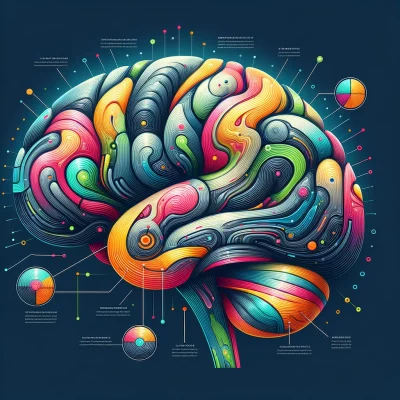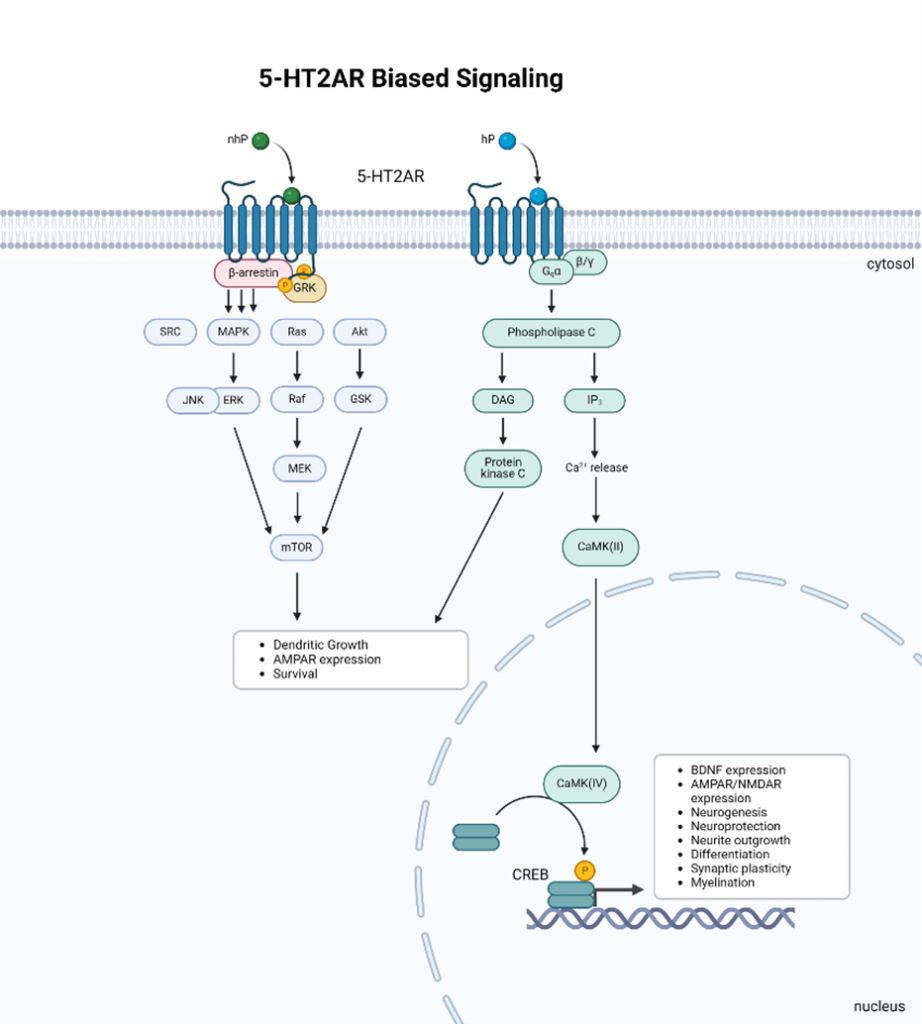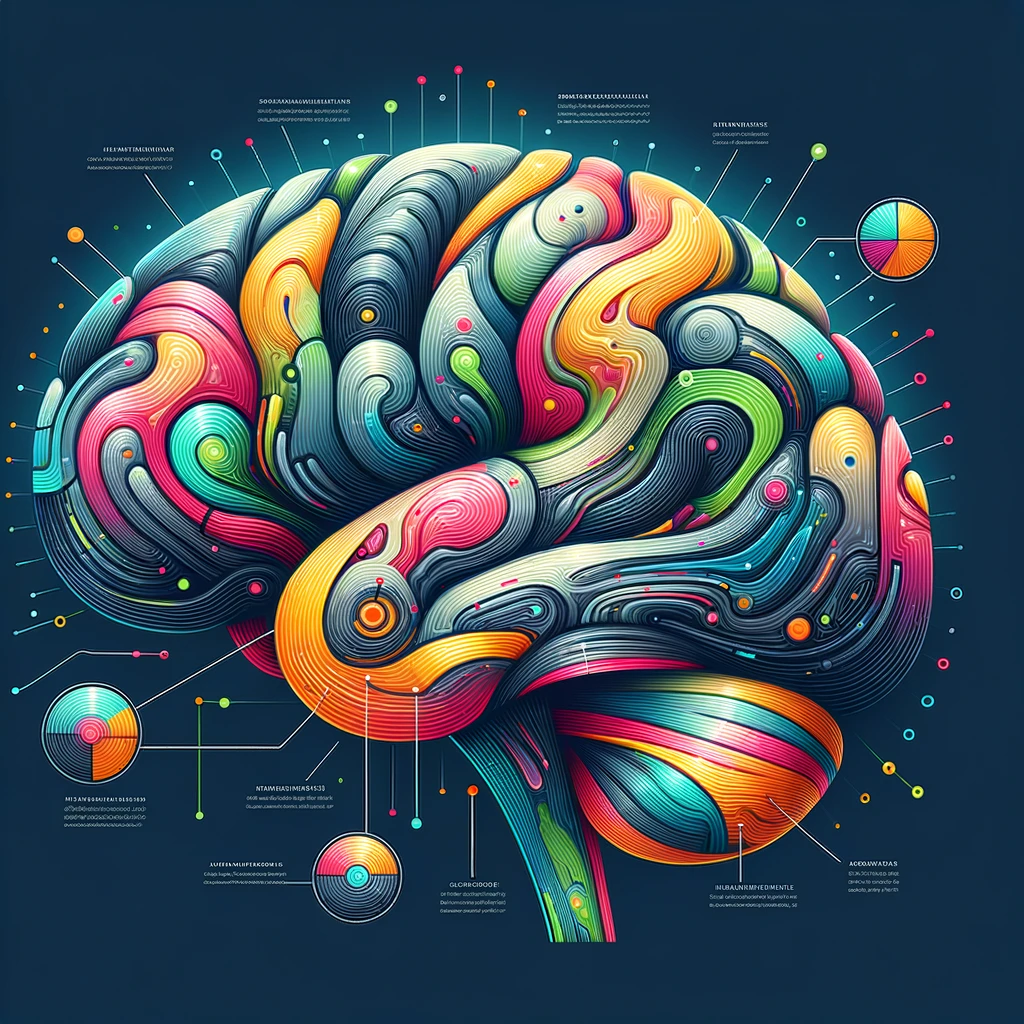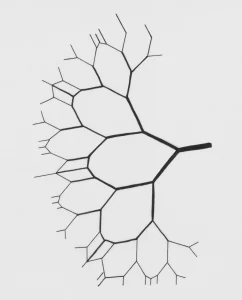
In recent years, psychedelics like psilocybin and LSD have gained significant attention for their potential to treat neuropsychiatric disorders, such as obsessive-compulsive disorder (OCD), depression, post-traumatic stress disorder (PTSD), and addiction 1. This shift in perspective is leading to increased acceptance among psychotherapists and psychiatrists, paralleling the clinical use of esketamine. Concurrently, there is a growing interest in understanding the mechanisms by which psychedelics and their analogues exert their effects, with the goal of designing novel neuropharmaceuticals 2.
Mechanisms of Action
Psychedelics primarily act through the serotonin receptor 5-HT2A, which activates both Gαq/11 and β-arrestin2 pathways (Figure 1.). However, it is still unclear which of these pathways is more critical for the therapeutic effects. Recent studies have shown that hallucinogenic psychedelics (e.g., psilocybin) and non-hallucinogenic psychedelics (e.g., Tabernanthalog, or TBG) may differentially activate these pathways 3. This differential activation can lead to changes in chromatin states at gene enhancers involved in synapse organization and neuronal plasticity 4. Despite these findings, significant gaps remain in our understanding of the cellular and neural mechanisms linking psychedelic-induced synaptic plasticity to behavioral outcomes. Additionally, it is unknown whether non-hallucinogenic psychedelics promote plasticity through the same mechanisms 5.

Figure 1. Biased signaling of 5-HT2AR: Gq- dependent and beta-arrestin dependent. nhP: non-hallucinogenic Psychedelics; hP: hallucinogenic Psychedelic.
Psychoplastogens: A New Class of Compounds
Psychoplastogens are substances capable of rapidly inducing structural and functional neuronal plasticity, which can modulate cognitive functions. These compounds may help rescue neuronal atrophy seen in many neuropsychiatric and neurodegenerative disorders by modulating neurotrophic factor expression, activating neuronal repair mechanisms, and mediating immune responses. The therapeutic potential of these compounds has been increasingly recognized, emphasizing the need to investigate existing natural compounds before embarking on the lengthy process of synthesizing new ones. This approach could leverage existing knowledge and reduce the costs associated with developing new substances 6.
Differentiating Psychedelics
Psychedelics are a family of psychoactive substances that induce altered states of consciousness, profoundly changing thoughts, emotions, and perceptions. They are distinct from other psychoactive compounds such as cannabinoids (e.g., THC), entactogens (e.g., MDMA), and dissociatives (e.g., ketamine). Despite strict regulations and illegality in many countries, there is a need to develop new psychedelic-based therapeutics with optimized pharmacological profiles to ensure safety and efficacy 7.
Psychedelics can be chemically classified into three main types: tryptamine analogues, ergoline derivatives, and phenethylamines.
Tryptamine Analogues
These compounds share the structural backbone of serotonin. Psilocybin and DMT are notable examples. Psilocybin, found in “magic mushrooms,” is converted in the body to its active form, psilocin, which produces mind-altering effects. DMT induces rapid and intense psychedelic experiences but has a short duration of action. It is necessary to balance the therapeutic potential with the strong hallucinogenic effects for clinical use.
Ergoline Derivatives
LSD is the primary example of this class, known for its potent hallucinogenic effects. Research is ongoing to develop non-hallucinogenic derivatives that can provide therapeutic benefits without the intense psychedelic experiences.
Phenethylamines
Mescaline, derived from certain cacti, is a key compound in this class. It produces visual and auditory hallucinations and has been studied for its potential therapeutic effects 7.
Non-Hallucinogenic 5-HT2AR Agonists
The therapeutic effects of psychedelics are often believed to be coupled with their hallucinogenic properties. However, preclinical evidence suggests that these effects can be separated. This raises an important question: how can we preserve the therapeutic benefits of psychedelics while minimizing or eliminating the hallucinogenic effects? A limited number of non-hallucinogenic 5-HT2A agonists have been identified. For example, 6-F-DET, a tryptamine analogue, lacks hallucinogenic effects but also has weak functional activity. Ergoline derivatives such as 2-Br-LSD and lisuride have shown potential for treating depression and other psychiatric disorders in animal studies, though lisuride has induced hallucinations in some patients with Parkinson’s disease 7.
IsoDMT derivatives, introduced in the 1980s, represent another group of non-hallucinogenic 5-HT2A agonists. Compounds like isoDMT and 5-OMe-isoDMT have been identified as non-hallucinogenic through drug discrimination tests. Recent studies by the Olson group have reported a series of isoDMT compounds that promote neuronal growth and have significant antidepressant effects in mouse models, presenting significant interest as psychoplastogens for clinical applications 8. One such compound, AAZ-A-154, has shown promise as a non-hallucinogenic psychoplastogen. Another compound, TBG, a simplified analogue of ibogaine, has been found to increase dendritic arborization and spine density in rat cortical neurons.
Future Directions and Clinical Applications
The potential to repurpose psychedelics for treating not only cognitive disorders but also neurological conditions characterized by neuronal atrophy is growing. However, substantial research is still needed to elucidate how these compounds stimulate neuroplastic mechanisms. It is crucial to determine the developmental stages at which treatment is most beneficial and understand how these compounds affect neuronal networks at different scales 9.
From a medicinal chemistry perspective, there is an urgent need to develop new chemical entities with optimized pharmacological profiles to create more effective and safer psychedelic-based therapeutics. This includes supporting research on 5-HT2A receptor agonists for use in various disorders, starting with antidepressants. Disturbances in 5-HT2A receptor signaling are well-known to be implicated in mental disorders such as schizophrenia, depression, anxiety, and addiction.
Advanced techniques are being developed to thoroughly investigate the hallucinogenic properties of psychedelics. These include novel recombinant receptors and optimized functional assays that help understand the molecular mechanisms underlying the therapeutic effects of psychedelics. As these compounds move towards clinical trials, it is essential to develop and use appropriate preclinical models that can accurately measure their hallucinogenic behaviors. While translating findings from rodents to humans is challenging, behavioral assays like the Head-Twitch Response (HTR) have been developed to distinguish between hallucinogenic and non-hallucinogenic psychedelics in vivo. 7
Conclusion
There is a growing space for the therapeutic use of psychedelic compounds, which can potentially be applied to both cognitive and neurological disorders characterized by neuronal atrophy. However, a considerable amount of research is still needed to fully understand how these compounds stimulate neuroplasticity and determine the most effective stages for treatment. This knowledge will help in developing new therapies that can effectively manipulate neuronal networks and provide significant benefits for a range of brain conditions.
References
- Mastinu, A. et al. The Bright Side of Psychedelics: Latest Advances and Challenges in Neuropharmacology. IJMS 24, 1329 (2023).
- Lowe, H. et al. Psychedelics: Alternative and Potential Therapeutic Options for Treating Mood and Anxiety Disorders. Molecules 27, 2520 (2022).
- Wallach, J. et al. Identification of 5-HT2A receptor signaling pathways associated with psychedelic potential. Nat Commun 14, 8221 (2023).
- Cameron, L. P. et al. A non-hallucinogenic psychedelic analogue with therapeutic potential. Nature 589, 474–479 (2021).
- De La Fuente Revenga, M. et al. Prolonged epigenomic and synaptic plasticity alterations following single exposure to a psychedelic in mice. Cell Reports 37, 109836 (2021).
- Benko, J. & Vranková, S. Natural Psychoplastogens As Antidepressant Agents. Molecules 25, 1172 (2020).
- Duan, W., Cao, D., Wang, S. & Cheng, J. Serotonin 2A Receptor (5-HT 2A R) Agonists: Psychedelics and Non-Hallucinogenic Analogues as Emerging Antidepressants. Chem. Rev. 124, 124–163 (2024).
- Dong, C. et al. Psychedelic-inspired drug discovery using an engineered biosensor. Cell 184, 2779-2792.e18 (2021).
- Saeger, H. N. & Olson, D. E. Psychedelic‐inspired approaches for treating neurodegenerative disorders. Journal of Neurochemistry 162, 109–127 (2022).













